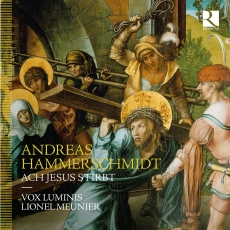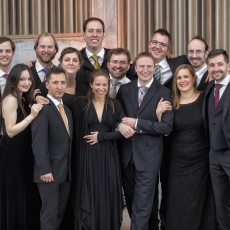Vox Luminis - Hammerschmidt: Ach Jesus stirbt - Early Music Review
A key figure in the mid-17th-century German world is Andreas Hammerschmidt (1611/2-1675) who was fluent in the emerging cantata style and equally at home in monody or the madrigalesque style of Italy. His sacred works were published over 15 volumes printed between 1639 and 1671 and combine polychoral motets with solo and dialogue pieces, many using thematic material derived from chorales. In some ways overshadowed by his better-known contemporary Schütz, he was among the creators of the sound world of Lutheran church music in which the contributors to the Altbachisches Archiv and ultimately Johann Sebastian Bach himself were formed. A lot of attention has been paid to Schütz and Schein, and to Buxtehude in the north, while Hammerschmidt is unjustly – on the basis of this fine recording – neglected.
Partly to remedy this, Vox Luminis – here using 13 singers – recorded this selection of his works in 2019, using the substantial organ by Dominique Thomas of 2002 in the north transept of the church of Notre-Dame at Gedinne in Belgium, where in 2017 they had recorded motets by Schein and Ahle for inclusion in an interesting CD devised by the remarkable Breton bassoonist, Jérémie Papasergio. The Hammerschmidt programme is structured around texts for Passiontide and Easter, beginning with the elegiac motet Ach Jesus stirbt, which is the title given to the whole CD. They work with the string group CLEMATIS, (2 violins, 2 violas and violone) and brass (2 trumpets, 3 trombones and bassoon), although the majority of pieces have just basso continuo with the voices.
Vox Luminis are at the heart of their comfort zone with this colourful and often surprisingly adventurous music. The balance, clarity and diction for which the group is justly celebrated are all in evidence in these subtle and well-paced performances. This is an important introduction to Hammerschmidt’s unique voice, but it is also a quite excellent performance of gripping music.
I like it a lot, and it offers far more than just filling another gap in the complex jigsaw of 17th-century Germany, where cross currents between national styles, composers’ opportunities to travel and the myriad small courts with their musical establishments was all part of creating an emerging late Baroque synthesis. Each performance is beautiful and moving in itself, but the cumulative effect is distinctive and compelling.
Some motets are in more in the old cori spezzati style; others employ echo effects, like Siehe, wie fein und lieblich ists in three choirs. In a newer and more obviously modern style, Ach Gott, warum hast du mein vergessen has four character voices, beginning with Ps 22.1 and ending with Alleluias, so taking us from the cross to the empty tomb. Its companion piece is Wer wälzet uns der Stein, where a pair of sopranos ask the question ‘Who will roll away the stone?’ A pair of violins dialogue with them, while violas and violone shadow the lower voices and a bright organ sound adds to the outburst of Easter joy. Restrained and sung by just four voices with continuo is O barmherziger Vater, while Christ lag in Todesbanden makes polyphony out of the chorale, setting it for two trebles and a tenor with three trombones and continuo. Easter is celebrated in a less antique Lutheran style in Triumph, Triumph, Victoria, which has upper voices in pairs – two sopranos, two tenors and then a different pair of sopranos – for the verses with two trumpets and three trombones with the tutti. For Ascension Day we have a motet based on upward scale passages that cumulates in tuttis capped by three trumpets. Very different is Vater unser, with four favoriti, a five-part string group and a capella of five voices joining for the tutti, and the poignant words Ist nicht Ephraim mein theurer Sohn, set memorably by Schütz, receives a haunting performance with just five voices.
As so often with Vox Luminis, the performances seem just right: no individualistic voices unbalance the perfect restraint, yet the outbursts of Easter joy are life enhancing. The choice of music not only illustrates the multiple styles to be found in Hammerschmidt, but shows how rich was the melting pot of middle Europe in these mid-17th-century years. This is an important CD, and no one should be without it.

